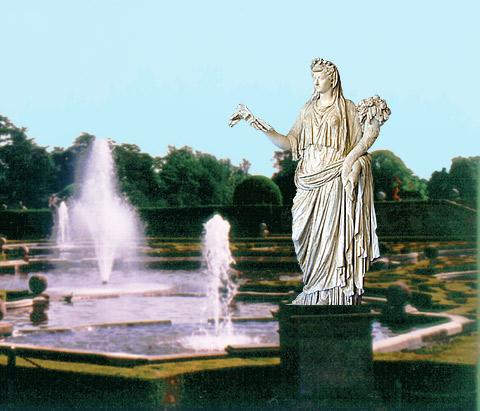
You climb the imposing staircase from the street and enter the courtyard of the portico (known in Latin as the Porticus Liviae). The large courtyard welcomes you with its cooling fountains, shady trees, flowers and greenery. In the center of the courtyard is a beautiful shrine to Concordia, goddess of peace and marital harmony. You see a striking statue of Livia, wife of Augustus; her crown of flowers and the cornucopia and sheaves of wheat that she carries tell you that she is portrayed as the goddess Ceres, who brings fertility and abundance to mortals. You think this symbolism is very appropriate when you remember what Pliny the Elder said about the fertility of the gardens in this portico:
Una vitis Romae in Liviae porticibus subdiales inambulationes umbrosis pergulis opacat, eadem duodenis musti amphoris fecunda. (Natural History 14.11)
"One vine in the Portico of Livia in Rome protects open-air strollers from the sun with its shady arbors, and that same vine is fertile enough to produce twelve amphoras of unfermented wine."
Livia and her son Tiberius dedicated this portico on January 1, 7 BCE, on the same day that Tiberius celebrated his triumph over the Germans. The portico was built on the site of an extremely luxurious house that had belonged to a wealthy aristocrat named Vedius Pollio. When Pollio died in 15 BCE, he left his house to the emperor Augustus, who immediately had the house torn down to demonstrate that he did not approve of such luxury and extravagance. The transformation of this private property into a public place of recreation which all Romans could enjoy was part of the message about his rule that Augustus wanted to convey to the people. The location of this portico, right on the edge of a very poor district of Rome, associated Livia with benevolence, with making the beauty, leisure, and culture of the upper classess accessible to the many.
The structure was 115 meters long and 75 meters wide, with an impressive double set of columns in the covered portico, which had a number of semicircular and square niches; this plan gives an idea of the layout, though no remains of the building have been found. In the center of the courtyard was a shrine to Concordia, the goddess of marital concord and harmony, an eminently appropriate deity for Livia to honor.
Besides offering shade from the sun and a lovely setting for a stroll, the porticoes of Rome were also art galleries, where various types of fine art were on display for the enjoyment of the public. Visit the east or west portico to see what exhibitions are available today.